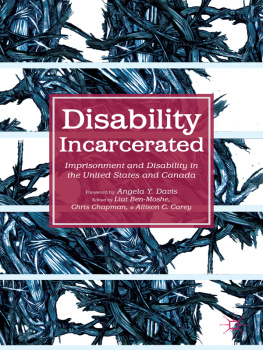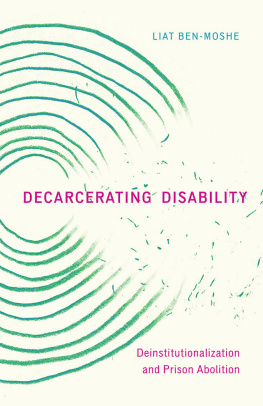LIAT BEN-MOSHE - DISABILITY INCARCERATED
Here you can read online LIAT BEN-MOSHE - DISABILITY INCARCERATED full text of the book (entire story) in english for free. Download pdf and epub, get meaning, cover and reviews about this ebook. year: 2014, publisher: Palgrave Macmillan, genre: Politics. Description of the work, (preface) as well as reviews are available. Best literature library LitArk.com created for fans of good reading and offers a wide selection of genres:
Romance novel
Science fiction
Adventure
Detective
Science
History
Home and family
Prose
Art
Politics
Computer
Non-fiction
Religion
Business
Children
Humor
Choose a favorite category and find really read worthwhile books. Enjoy immersion in the world of imagination, feel the emotions of the characters or learn something new for yourself, make an fascinating discovery.
- Book:DISABILITY INCARCERATED
- Author:
- Publisher:Palgrave Macmillan
- Genre:
- Year:2014
- Rating:3 / 5
- Favourites:Add to favourites
- Your mark:
- 60
- 1
- 2
- 3
- 4
- 5
DISABILITY INCARCERATED: summary, description and annotation
We offer to read an annotation, description, summary or preface (depends on what the author of the book "DISABILITY INCARCERATED" wrote himself). If you haven't found the necessary information about the book — write in the comments, we will try to find it.
DISABILITY INCARCERATED — read online for free the complete book (whole text) full work
Below is the text of the book, divided by pages. System saving the place of the last page read, allows you to conveniently read the book "DISABILITY INCARCERATED" online for free, without having to search again every time where you left off. Put a bookmark, and you can go to the page where you finished reading at any time.
Font size:
Interval:
Bookmark:
Disability Incarcerated
Disability Incarcerated
Imprisonment and Disability in the United States and Canada
Edited by
Liat Ben-Moshe, Chris Chapman, and Allison C. Carey


DISABILITY INCARCERATED
Copyright Liat Ben-Moshe, Chris Chapman, and Allison C. Carey, 2014.
All rights reserved.
First published in 2014 by
PALGRAVE MACMILLAN
in the United Statesa division of St. Martins Press LLC,
175 Fifth Avenue, New York, NY 10010.
Where this book is distributed in the UK, Europe and the rest of the world, this is by Palgrave Macmillan, a division of Macmillan Publishers Limited, registered in England, company number 785998, of Houndmills, Basingstoke, Hampshire RG21 6XS.
Palgrave Macmillan is the global academic imprint of the above companies and has companies and representatives throughout the world.
Palgrave and Macmillan are registered trademarks in the United States, the United Kingdom, Europe and other countries.
ISBN: 9781137393234 (hc)
ISBN: 9781137404053 (pbk)
Library of Congress Cataloging-in-Publication Data
Disability incarcerated : imprisonment and disability in the United States and Canada / edited by Liat Ben-Moshe, Chris Chapman and Allison C. Carey.
pages cm
ISBN 9781137393234 (hardcover : alk. paper)
ISBN 9781137404053 (pbk. : alk. paper)
1. Sociology of disability. 2. Prisoners with disabilitiesUnited States. 3. Prisoners with disabilitiesCanada. 4. People with disabilitiesInstitutional care--United States. 5. People with disabilitiesInstitutional careCanada. I. Ben-Moshe, Liat. II. Carey, Allison C.
HV1568.D5688 2014
365.60870973dc23 2013040052
A catalogue record of the book is available from the British Library.
Design by Newgen Knowledge Works (P) Ltd., Chennai, India.
First edition: May 2014
10 9 8 7 6 5 4 3 2 1
Contents
Angela Y. Davis
Allison C. Carey, Liat Ben-Moshe, and Chris Chapman
Chris Chapman, Allison C. Carey, and Liat Ben-Moshe |
Chris Chapman |
Philip M. Ferguson |
Geoffrey Reaume |
Nirmala Erevelles |
Allison C. Carey and Lucy Gu |
Jihan Abbas and Jijian Voronka |
Michael Rembis |
Syrus Ware, Joan Ruzsa, and Giselle Dias |
Erick Fabris and Katie Aubrecht |
Shaista Patel |
Mansha Mirza |
Mark Friedman and Ruthie-Marie Beckwith |
Liat Ben-Moshe |
Robert McRuer
Stewart Bell
Foreword
Angela Y. Davis
Disability Incarcerated is an exciting development at the intersection of the fields of critical prison studies and disability studies. The anthology not only represents important scholarly work in these fields, but it also stages conversations across numerous borders, including the one separating the United States and Canada and those that strive to divorce scholarship and activism. When I was first introduced to the ideas explored in this collection, I remembered a scene from the era of my own incarceration. After being informed about a decision made by officials in the New York Womens House of Detention regarding the section of the jail where I would be housed, I was taken to the fourth floor into an area reserved, in the language of that period, for emotionally and psychologically disturbed inmates. The only woman in that unit who was not entirely immobilized by the psychotropic drugs distributed to everyone there informed me that she was doing everything in her power to persuade the authorities to release her into the main population. She also sternly urged me to refuse to take the drugs.
When I tried to understand why a person arrested on political charges would be implicitly labeled emotionally or psychologically disturbed, the most accessible frame of reference at the time was the well-publicized use of psychiatric institutions to punish political dissidents in other parts of the world. The fact that I was being similarly treated demonstrated, I thought, that the United States, despite its official protests vis--vis the then Soviet Union and China, also engaged in punishment practices that conflated political resistance with psychological disorders. I was especially struck by the fact that guards did indeed try to coax me to imbibe the medication indiscriminately distributed to the women there. After a legal injunction forced the authorities to transfer me to the main population, I learned from my fellow prisoners that the psychotropic medication I had been offered was probably either thorazine or chloral hydrate.
What surprised me even more than my assignment to the psych unit of the jail was the recognition that the prisoners I encountered in the main population were thoroughly familiar with the psychotropic medication regimes and treated them as an entirely routine phenomenon. I learned that many women in the main population were on the same drugs I had refused in the psych unit. Having been active in a number of campaigns in defense of political prisoners, I assumed I was somewhat knowledgeable about prison conditions, but since I had primarily encountered mens prisons, I was entirely unaware of the structural conflation of deviant and disabled women. At the time, although I lacked an analytical vocabulary to understand this convergence, I suspected that that there was a far deeper significance to this experience than I was able to surmise. And indeed, over the last four decades, my thoughts have periodically returned to that experience. But it was not until I read Disability Incarcerated that I realized how important it is to pose such probing questions about the complex intersections of imprisonment and disability. This collection of essays asks the questions I wish I had known how to formulate then and so many more that have only become possible in the aftermath of two decades of intense research and passionate activism against the prison industrial complex and after the emergence of fields of study and radical activism around the category of disability.
The three largest contemporary psychiatric facilities, this volume dramatically reveals, are jails: Cook County Jail in Chicago, L. A. County Jail, and Rikers Island in New York. A direct consequence of the closure of psychiatric institutions called for by progressive deinstitutionalization advocacy, this current crisis is also an outcome of strategies proposed to trim national and state budgets. In general, current policies of mass incarceration have led to a daily census count in US jails, prisons, and other sites of imprisonment of almost two and a half million people. It has been established by numerous researchers that the disproportionate number of prisoners of color reveals how structural racism underpins what is often represented as due process. That aboriginal people in Canada are approximately ten times more likely than nonindigenous people to be sent to jail reveals that Canada seems to be following its southern neighbors example by using imprisonment to deflect attention from pressing social problems. In both the United States and Canada, there are efforts currently underway to reduce the imprisoned populationranging from abolitionist strategies that are linked to broader demands for social justice to calls for decarceration that will reduce the fiscal resources necessary to keep prisons functioning. If the radical core of prison abolitionism is not to be sacrificed on the altar of fiscal responsibility, lessons from the deinstitutionalization movement should be heeded.
Next pageFont size:
Interval:
Bookmark:
Similar books «DISABILITY INCARCERATED»
Look at similar books to DISABILITY INCARCERATED. We have selected literature similar in name and meaning in the hope of providing readers with more options to find new, interesting, not yet read works.
Discussion, reviews of the book DISABILITY INCARCERATED and just readers' own opinions. Leave your comments, write what you think about the work, its meaning or the main characters. Specify what exactly you liked and what you didn't like, and why you think so.













